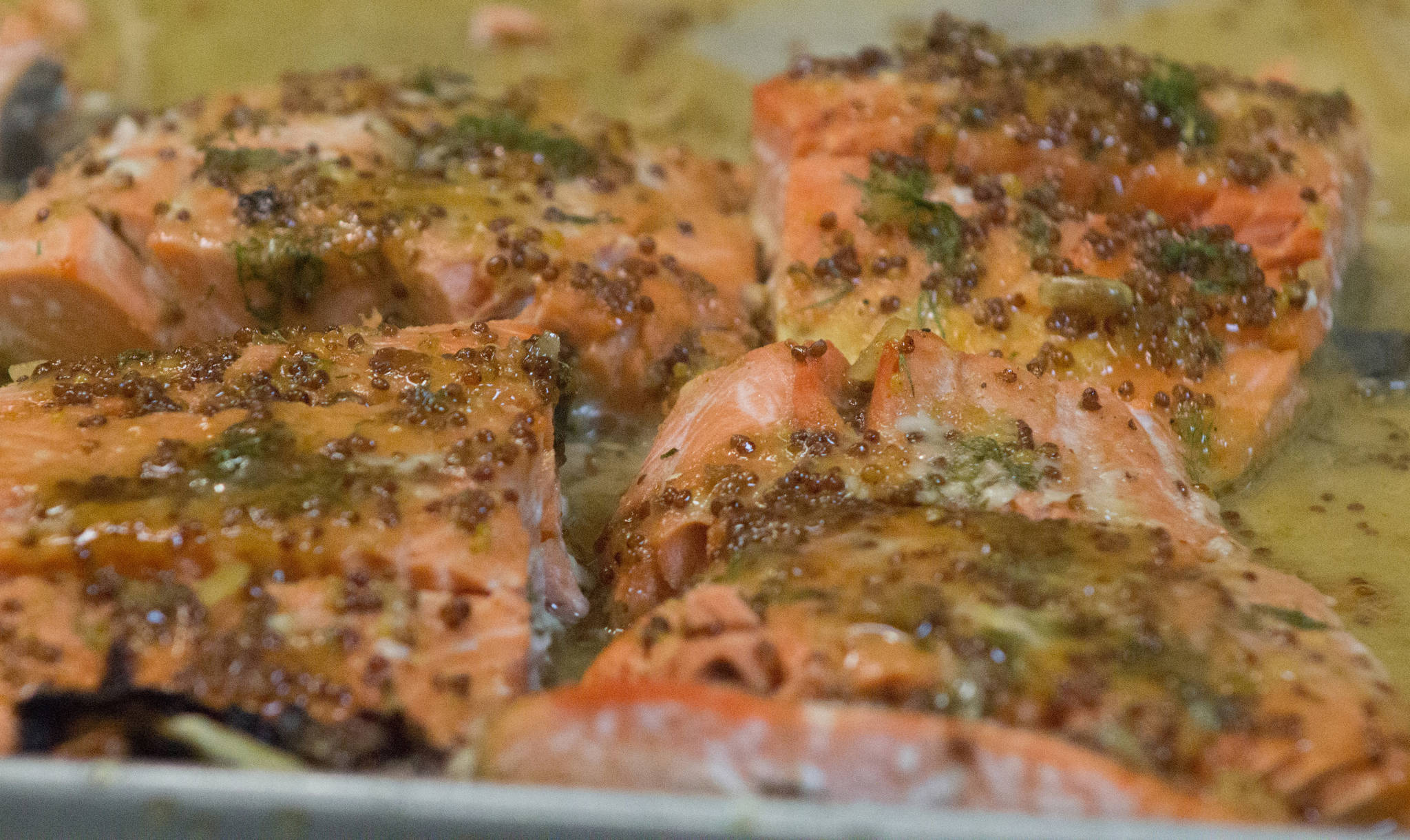Cooking on a boat is not always smooth sailing. Working with storage space, equipment and ingredients — and often an overabundance of fish — to please and feed a crew presents a formidable challenge for the cook on board.
Morgan Stewart, the chef on the R/V Tiglax, discussed the highs and lows of cooking at sea at a class for boat cooks at The Classic Cook in Homer on Sunday, April 9. The galley cooking class was a collaboration between Stewart, Salmon Sisters, Alaska Marine Conservation Council and the Alaska Young Fishermen’s Network, Stewart said.
“I had done a cooking class before with Salmon Sisters, and we tweaked it to be more affordable from donations from Salmon Sisters so we could have more people and have a discussion about life on boats,” Stewart said.
Stewart walked the class through six recipes: smoked herring caesar salad, mustard-glazed salmon, pesto-parmesan potatoes, roasted cabbage steaks, roasted vegetable and salmon pearled barley salad, and strawberry short biscuits and cream. Throughout the cooking demonstration, Stewart encouraged the class participants to ask questions and share experiences about cooking aboard a seafaring vessel.
“I was looking forward to hearing what people had to say because their experiences are vastly different from mine, whether that’s because they’ve been doing it for a long time or are brand-new. They have different perspectives.”
Jack Hamik, who has been commercial fishing since 1979, attended the class to learn some new ideas for cooking aboard his boat. He thought the pesto-parmesan potatoes and the cabbage steaks were good ideas.
“I want to liven up some of my meals,” Hamik said. “I have to cook 100 in a row and they get tired halfway.”
As the students chimed in, there was often a discrepancy between the resources Stewart has on the Tiglax — a U.S. Fish and Wildlife Service research vessel that supports scientists studying marine wildlife — and those found on a typical fishing vessel. The Tiglax tends to have more space in the kitchen, as well as for storage, and is stocked with a wider variety ingredients, Stewart said.
However, there were many points where the group shared similar experiences and struggles. One of the points discussed during the class was how to make fish palatable when the crew is sick of eating fish. One suggestion from the group was a salmon burger with bleu cheese and green apple, which would make the salmon flavor unique enough to encourage tired tongues to enjoy it. Stewart added that she makes salmon burgers with barbecue sauce for a change in flavor.
Stewart has cooked on the Tiglax for five summers and enjoys the challenge of cooking on a boat. It was a change in pace from working in a restaurant year-round.
“You get to see so many cool things when you’re not in one building. You get to see what Alaska has to offer,” Stewart said. “I work by myself. its a very different mindset. You’re trying to make people happy. It presents itself as a little bit of a different challenge. I do like working in restaurants, but (working on the Tiglax) helped me … rely on myself and know how to work on a tight timeline.”
Cooking on a boat presents many challenges, including preserving food for the duration of the journey, keeping food waste low, using limited supplies to their fullest, and having enough — but not too much — food for the crew, Stewart said. Aboard the Tiglax, she often has to plan around food allergies and special diets as well.
During the class, she reminded the group to check their crates of produce all the way through to make sure there aren’t rotting items in the middle or the bottom. Since produce goes bad quickly, having good fruits and vegetables at the beginning of the journey is important.
After graduating from Johnson and Wales University’s culinary program in Denver, Stewart worked in Homer restaurants, including Two Sisters. Now, she spends her summers at sea and travels in the off-season to expand her culinary knowledge. She also started her own business, Gypsy Kitchen, as an outlet to cater small events and teach cooking classes like the one at the Classic Cook.
“I’ve been doing more food-focused travel with internships and stuff like that,” Stewart said. “Last winter I spent three weeks in France at a charcuterie school. I also spent three months in Australia as a butcher’s assistant.”
_____________________________
Mustard-glazed salmon
16 ounces salmon
2 tablespoons stone-ground mustard
1/2 cup white wine or light beer
1/4 cup sugar
1 clove garlic, chopped
1 teaspoon salt
pinch of cayenne pepper
2 teaspoons fresh dill, chopped
To make the glaze, simmer all the ingredients except the salmon and dill. One of the glaze has thickened, spoon a little of it on top of the salmon and top with dill. Bake at 350F for about 30 minutes or until done, spooning the glaze over the salmon every so often.
Pesto-parmesan potatoes
6 medium red potatoes, rinsed and cut into 1/2-inch cubes
1/4 cup pesto
1/4 parmesan
2 teaspoons salt
1 teaspoon pepper
1/4 cup butter, melted.
Boil potatoes until soft, but still a little firm. Drain, then toss with remaining ingredients.


